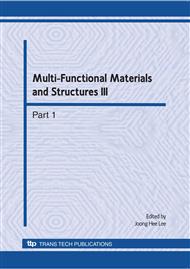p.1179
p.1183
p.1187
p.1191
p.1195
p.1199
p.1203
p.1207
p.1211
Study on Mechanical Properties of Wood Fiber/Polypropylene Composites
Abstract:
In this study, the effect of wood fiber concentrations on the mechanical properties of composites, prepared by using MAPP as the coupling agent, was investigated. In the sample preparation, four levels of fiber loading and three compounding temperatures were used. Most major changes in composite performance occurred at fiber contents above 30 wt%.The results clearly showed that the fiber loading of 30 and 40 wt% at 190oC was provided adequate reinforcement to increase the tensile and flexural strength of the PP powder. The modulus also increased with increasing the fiber content, because poplar fibers are believed to be more rigid than polymer. However, the addition of wood fibers resulted in a decrease in elongation and impact properties of the composites.
Info:
Periodical:
Pages:
1195-1198
Citation:
Online since:
August 2010
Authors:
Price:
Сopyright:
© 2010 Trans Tech Publications Ltd. All Rights Reserved
Share:
Citation:


